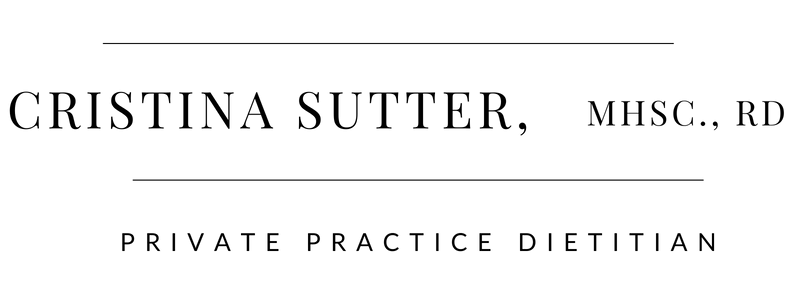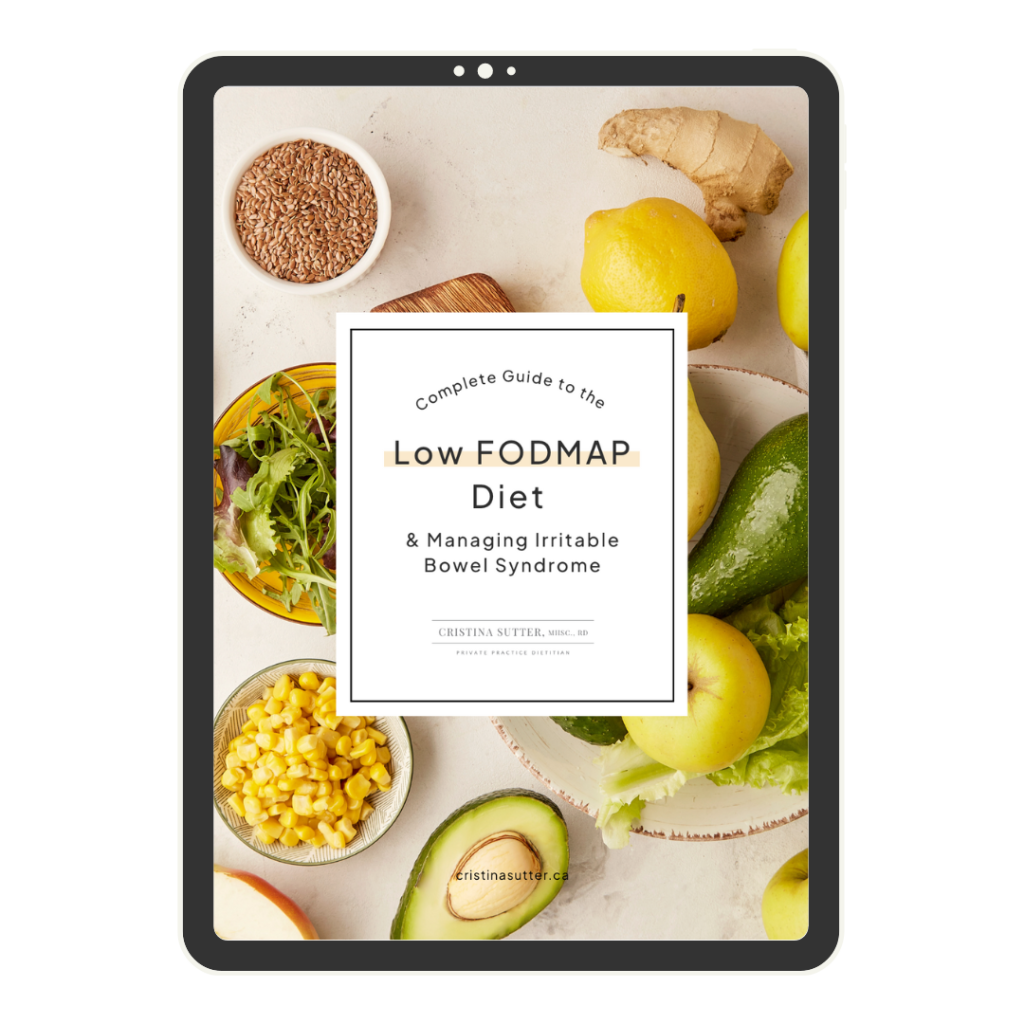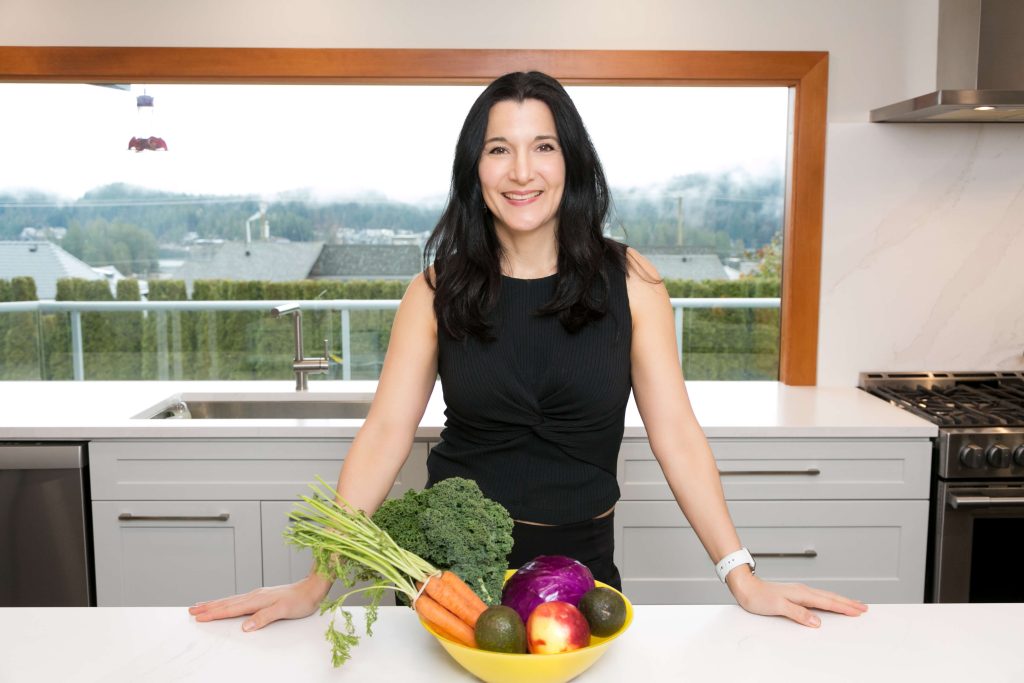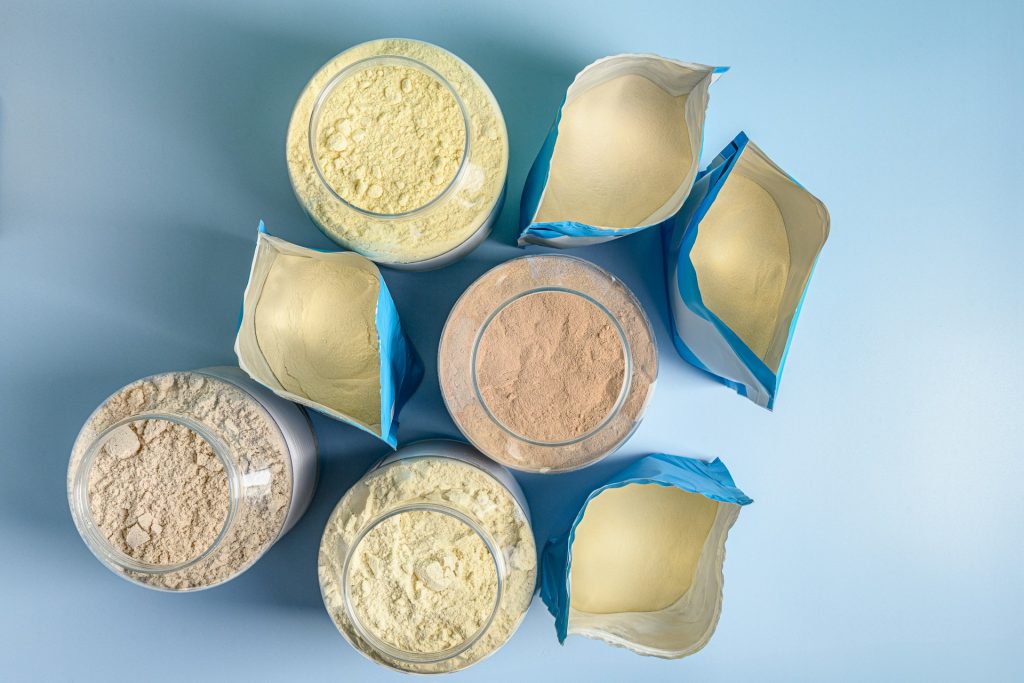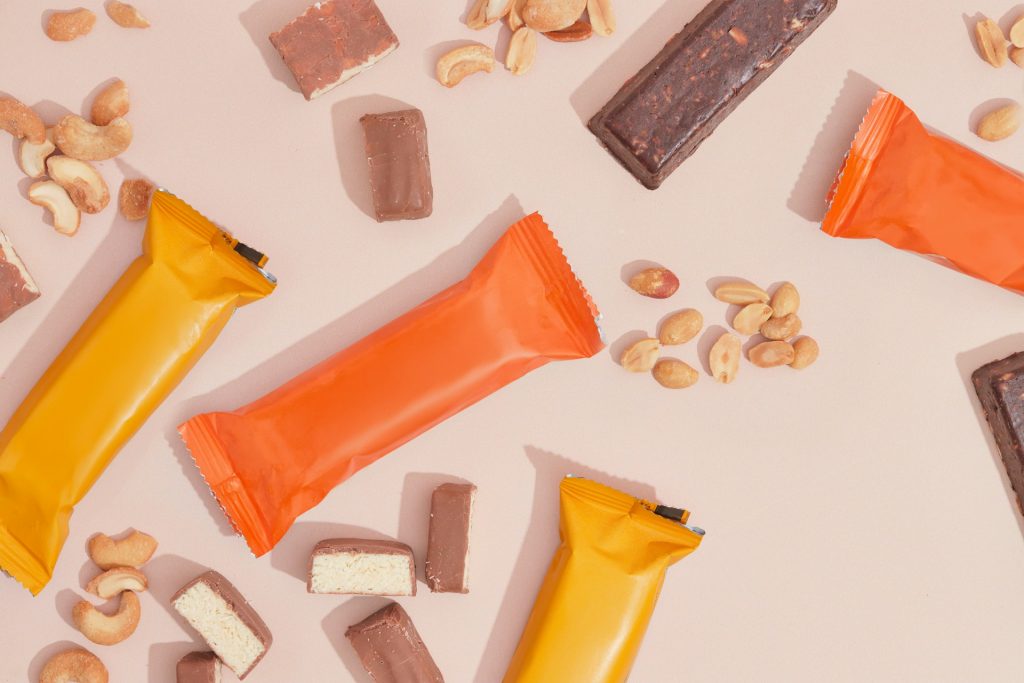If you have sugar cravings every afternoon, with your tea, after dinner, or when you watch TV, you’re not alone. Sugar cravings are incredibly common, but they aren’t a sign of a lack of willpower. Sugar cravings come from a number of physiological and psychological signals that we can understand and overcome.
Why Do We Have Sugar Cravings?
Understanding the root cause of your cravings is the first step toward gaining control.
Sugar cravings stem from:
- Blood sugar crashes
- Brain cues
- Lack of sleep
- Emotional stress
- Routine habits
- Environmental cues
- Hormone changes
- Even our gut microbiome
All these factors can trigger that intense desire for sugar.
Sugar Craving Root #1: Blood Sugar Crashes
I like to compare carbohydrate foods to the kindling and logs used to build a fire.

Kindling carbs are refined and break down into sugar quickly, just like kindling burns quickly and dies out quickly.

Log carbs are high in fibre and protein and take time to break down and release energy steadily over several hours, just like how logs burn in a fire for hours.

When we eat kindling carb foods like white rice, chips and granola bars, they can cause a rapid spike in blood sugar, followed by a sharp crash. This “sugar crash” signals your brain to seek another quick energy source, leading to a vicious cycle of cravings. In essence, you are trying to fuel your body’s fire with kindling, and the fire keeps going out, so you have to keep dumping more wood in.
Sugar Craving Root #2: Brain Cues
Our brains are wired to seek rewards. If you regularly have something sweet with your cup of tea or after dinner, your brain learns to expect sweets in those situations. A very common brain cue for snacks is sitting on the couch while watching TV. This creates a powerful brain neural pathway that makes you crave sweets every time you sit down to watch TV, have a cup of tea or finish your dinner.
Sugar Craving Root #3: Lack of Sleep
Insufficient sleep disrupts the hormones that regulate appetite. It increases ghrelin (the “hunger hormone”) and decreases leptin (the “fullness hormone”), making you more likely to crave high-calorie, high carb foods. When we are tired, we look for sugar to give us a boost in energy similarly to caffeine. On top of that, when you are tired, you crave easy comfort food (like takeout) and have less energy to prepare a wholesome meal with vegetables and a salad.
Sugar Craving Root #4: Stress and Emotions
When we’re stressed, our bodies release cortisol, which can increase our appetite and cravings for high carbohydrate, sugary “comfort” foods. Many people also use sugar as a way to self-soothe or cope with difficult emotions like feeling depressed, loneliness or anxious. Emotional eating can turn from a coping mechanism into a vicious cycle that can be hard to stop.
Sugar Craving Root #5: Routine Habits
It is easy to get into the habit of snacking when we are bored, while we are cooking or putting away leftovers. Students might snack on sweets while studying and parents might snack on sweets while working. Many of us grew up having dessert after dinner or something sweet in the afternoon. These routine eating habits don’t take our hunger into consideration and can become ingrained.
Sugar Craving Root #6: Food Environment
Our eating habits are strongly influenced by our food environment: if it’s there, we’ll eat it.
When we see food, we are more likely to eat it. People who live in downtown Vancouver often eat out a lot more than people who live in suburban areas, because they are surrounded by restaurants every time they step out the door. People who work in an office that is stocked with treats will eat the treats because they are within line of sight. Whether you leave fruit or cookies on the counter, you will eat more of them compared to if they are in the cupboard.
Sugar Craving Root #7: Hormone Changes
PMS is well known for physical and emotional changes in the body, including strong cravings. During the luteal phase (the time between ovulation and your period), the estrogen levels drop and progesterone rises, which can lower serotonin levels and cause blood sugar to drop, triggering hunger and cravings for quick energy from sugar.
Sugar Craving Root#8: Gut Health
The bacteria in our gut can influence our food preferences. An imbalance in gut flora, with an overgrowth of yeast or certain bacteria, can actually increase your sugar cravings, as these microorganisms feed on it.
Strategies for Overcoming Sugar Cravings from a Dietitian
While it may seem like cravings control you, there are effective strategies you can implement to manage them. To curb cravings, you can try to balance meals with protein and fiber, stay hydrated, improve sleep, manage stress and emotions, and create a supportive food environment and eating habits.
The goal is not complete deprivation, but balance and mindful choices.
- Build a Balanced Plate:
Ensure every meal contains a good source of protein and high-fibre carbohydrates (like vegetables, whole grains, and legumes). This combination slows digestion and promotes stable blood sugar levels, preventing the dramatic spikes and dips that trigger cravings. Make sure to have a full serving of carbohydrates at each meal. If you try to go low-carb, this will lead to more carb cravings later.
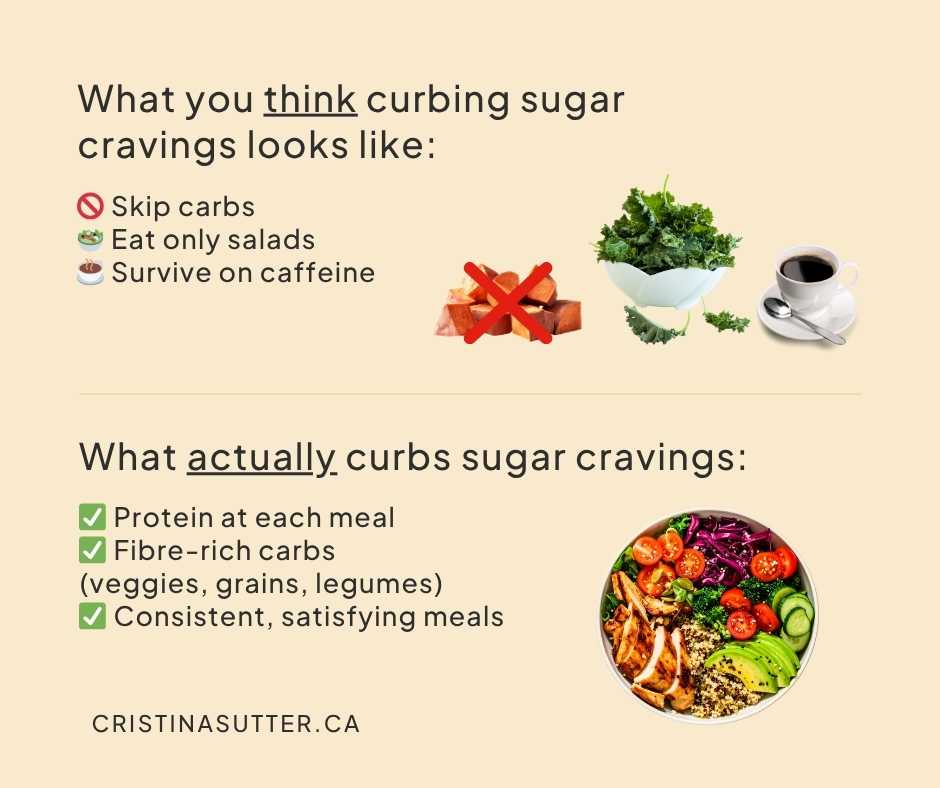
- Tackle Your Brain Cues: If you have gotten used to snacking on treats every time you relax on the couch to watch TV, you can disrupt this brain cue. Keep your hands busy while watching TV by playing the guitar, knitting, coloring, doing a puzzle or playing scrabble while you watch TV. Some people might switch from a black tea to a herbal tea when they transition away from sweets at tea time. Another strategy is to brush your teeth after dinner or chew gum to change your palate away from needing sweets.
- Prioritize Sleep:
Aim for 7-9 hours of quality sleep per night. A well-rested body is better equipped to regulate appetite hormones and make thoughtful food choices. - Find Healthy Ways to Manage Stress:
Instead of turning to sugar, explore other stress-relief techniques and activities. A short walk, deep breathing exercises, listening to music, or calling a friend can be powerful ways to manage stress without derailing your health goals. If self-care is new to you, try working with a counsellor to find strategies that work for you. - Routine Habits:
Try being mindful not to snack while doing the dishes or your homework. Practice sitting down to eat, without distractions. This can be hard, as we are used to eating with distractions and grazing on the go. Serve yourself on a plate, sit down, and experience your food mindfully. - Clean Food Environment:
Stock up on healthy snacks like fruits, chopped vegetables, and prepared salads or batch-cooked meals. Consider deleting Uber Eats from your phone. Don’t buy family-sized treats from Costco. Buy kids snacks that are not irresistable to you. Don’t buy treats just because they’re on sale; if they’re in your kitchen, you will eat them. - Don’t Forbid, Be Mindful:
Being overly restrictive often backfires, leading to intense cravings and potential binges. Allow yourself a small, planned indulgence. Choose a high-quality treat, savour it slowly, and enjoy it without guilt. A square of dark chocolate or a small scoop of ice cream can satisfy a craving without sabotaging your efforts. - Drink Water and Eat Fibre
Choose foods naturally high in fibre to optimize your gut health, aiming for 10g fibre at each meal. Include a serving of whole grains, fruits, vegetables, seeds or beans at most meals to reach your fibre intake. Drink 2 liters of water a day, plus one extra litre for every hour of vigorous exercise.
Plan for Success:
Keep healthy, satisfying snacks on hand for when cravings strike. A piece of fruit, a handful of nuts, Greek yogurt with berries, or a hard-boiled egg can provide the energy and nutrients you need to move past the craving.
Managing sugar cravings is a journey, not a destination. By understanding your personal triggers and implementing these balanced strategies, you can take control of your sweet tooth and foster a healthier relationship with food.
